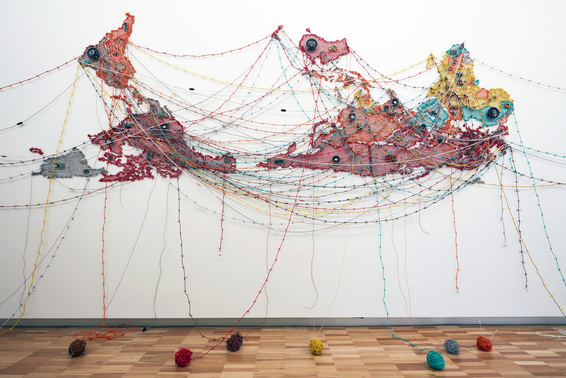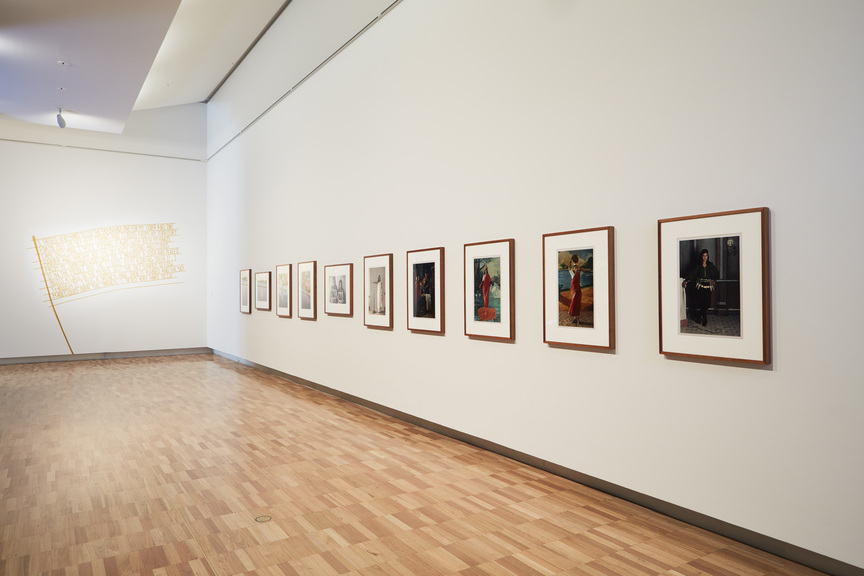-
From Current Issue
-
- Editor’s Letter Fire in the Heart
- Reviews I Gusti Ayu Kadek Murniasih
- Reviews 11th Seoul Mediacity Biennale: “One Escape at a Time”
- Dispatch Networked China
- One on One Monira Al Qadiri on Yukio Mishima
- Essays The rise of independent art spaces in pandemic-era Shanghai
- Features Tuan Andrew Nguyen
- Table of Contents
- Web Exclusives
- Archive
- Subscribe

R
E
V N
E
X
T
Installation view of NALINI MALANI’s Mother India: Transactions in the Construction of Pain, 2005, five-channel video with color and sound: 5 mins, dimensions variable, at “Fearless,” Art Gallery of New South Wales, Sydney, 2018. Copyright the artist. Courtesy the Art Gallery of New South Wales.
For an exhibition of only 15 works, “Fearless: Contemporary South Asian Art,” at the Art Gallery of New South Wales (AGNSW) packed a punch. The show and its works—primarily drawn from the Gallery’s collection—reflected the institution’s strengths in collecting and curating from the region, despite it being AGNSW’s first presentation on female artists with ties to South Asia. This historical marginalization was duly acknowledged, in the exhibition collateral as well as in the accompanying series of talks around women in South Asian art and the politics of borders and migration.
The introductory wall text stated that “each artist interrogates connections to diverse cultures and geographies, fearlessly questioning historical events, personal memories and their own identity.” Here, it is suggested that this fearlessness is radical in the context of rigid socio-political structures and the individual experiences they seek to oppress, and sets up the show as a consideration of shifting borders, through a feminist, South Asian lens.
While the works in the show date from 1991, it was a new commission that dominated the entrance. An unsettling buzzing emanates from the electrical circuits embedded in Reena Saini Kallat’s Woven Chronicle (2018), which depicts migratory paths across an inverted world map. Countries and the routes between them were marked by plastic-coated electrical cables and tied with knots emulating barbed wire, in a skillful interweaving of ideas of containment and displacement, traditional craft and new technology.
While Kallat explores the immensity of global human migration by representing individuals as minute electrical impulses, the photographic series “Native Women of South India” (2000–04) by Pushpamala N and Clare Arni restages images purporting to represent said women, seen in traditional paintings, film posters, mug shots, and religious imagery. Posed within dioramas, these works recontextualize and question the romanticization of female labor, and the representation of women as submissive, flirtatious or anthropological. They highlight a parallel between the ascribing of a particular identity to women and the ascribing of a national identity to many South Asians as a result of the Partition.
Identity is mutable, and many works address the fluctuations of supposedly rigid borders. Shilpa Gupta’s wall drawing of a flag, Untitled (There Is No Border Here) (2005–06), employs a more poetic metaphor to explore this, using barrier tape to spell out the words:
I tried very hard to cut the sky in half, one for my lover and one for me. But the sky kept moving and the clouds from his territory came into mine…I built a wall in the middle, but the sky started to flow through it…
Installation view of “Fearless” at the Art Gallery of New South Wales, Sydney, 2018. Photo by Mim Stirling. Courtesy Art Gallery of New South Wales.
Dayanita Singh’s work Suitcase Museum (2017–18) also embraces the unfixed perspective. It consists of 44 books, framed so only the photographs on their front and back can be viewed. These are stored within leather cases that were presented at the end of a hall, where a selection of books were hung and rotated during the course of “Fearless,” inviting multiple narratives to emerge. Singh intends the sequence of photographs to change with each temporary iteration of the “museum”; however, it was a somewhat frustrating arrangement as the impulse was to handle the books. This was a reminder of how history continues to be written by authority—in this case by the institution charged as custodian of this work.
Nalini Malani’s five-channel video work, Mother India: Transactions in the Construction of Pain (2005) is at the heart of the show. Its looped soundtrack of wrenching cries, mutterings and sped-up female voices—which followed viewers around the exhibition—were overlaid with accompanying images of faces partially illuminated and stained with red; of bodies lying in state; of the Indian flag; and of women at spinning wheels. It encapsulates the trauma contained within women’s bodies and the memories of those subject to history’s vagaries.
“Fearless” demonstrated strength in the variety of material and conceptual explorations undertaken by South Asian women artists over the past three decades, and the quality of this aspect of the Gallery’s collection. It may be the first exhibition of such work at AGNSW, but hopefully this is just the start.
“Fearless: Contemporary South Asian Art” is on view at Art Gallery of New South Wales, Sydney, until January 13, 2019.
To read more of ArtAsiaPacific’s articles, visit our Digital Library.













